Sago worms are one of the food items that come naturally with the Mentawai’s staple food, sago flour. The worms grow in felled palm trunks or saplings. They are not worms but larvae and pupae of the Palm Weevil beetles (Rhynchophorus sp.). These beetles are worldwide regarded as a significant pest of palm trees.

Geographic distribution
By the beginning of 2024, at least ten recognized species of Rhynchophorus beetles infested nearly all palm-growing areas worldwide.

Distribution map of Palm Weevil beetles worldwide, according to this source.
Rhynchophorus vulneratus (Panzer, 1798) is commonly found in Indonesia. Furthermore, Rhynchophorus lobatus (Ritsema, 1882) was described to occur in Sumatra. Many pictures of the ‘Red Stripe Weevil’ R. vulneratus can be found online. For R. lobatus, however, no single picture could be seen.
The appearance of sago worm beetles at Siberut Island
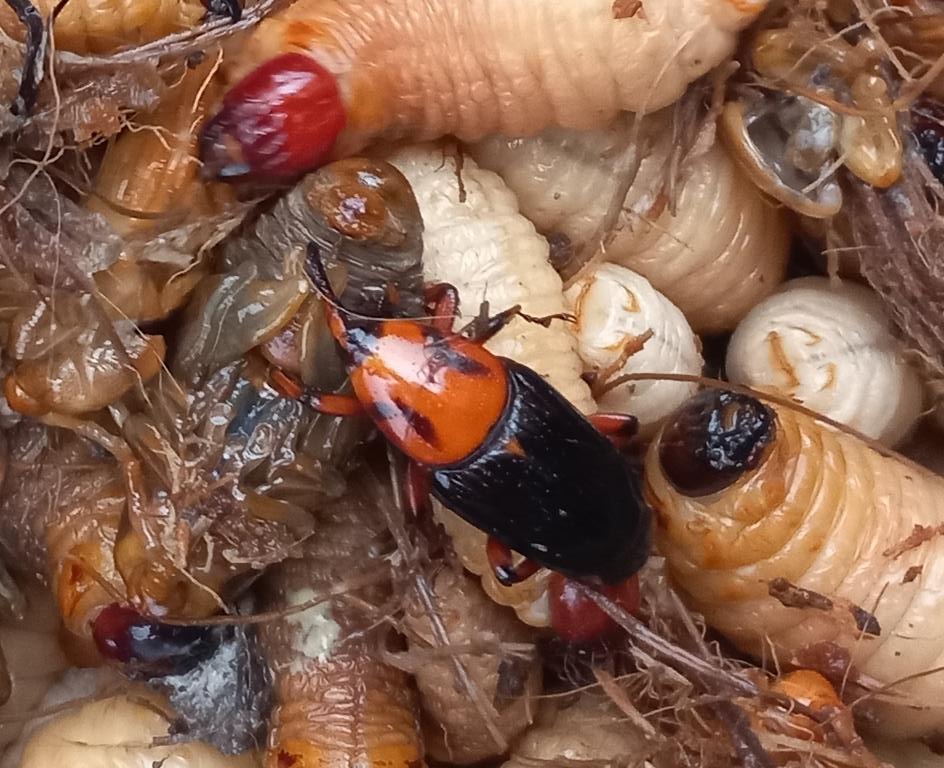
The beetle of sago worms I ate with the Mentawai people had a different appearance than R. vulneratus. This Red Stripe Weevil has a dark abdomen and a distinctive red stripe in the middle of the Thorax shield (pronotum).

See the above examples, which were presented in this publication.
Sago worm beetles at Siberut Island also have a dark abdomen but a distinctive, orange-colored thorax with two dark side stripes. This could be R. lobatus or an endemic yet undescribed species from Siberut. If a reader of this article can offer more insight into this question, his/her comment would be highly appreciated.
Besides my picture above, I found one video online that showed the same unidentified species of palm weevil together with Mentawais as I did. See the video still from this source below.
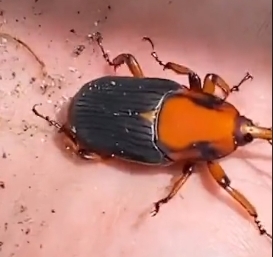
Where to find sago worms?
Palm weevils – and therefore sago worms – are attracted in two ways. One is when people slash a trunk opening in saplings of mature sago palms. The other possibility is that the beetles settle in felled palm trunks.
When sago is harvested, the main sago content in the trunk is from about 1 meter above the ground floor up to a height of 2/3 of the palm trunk. The remaining 1-meter-high stump of a sago palm is an ideal breeding ground for the beetle larvae. The last 1/3 of the trunk is used for animal feed (pigs like these parts of the trunk) or left on the ground. Again, when left, it will be speedily taken over by beetles.

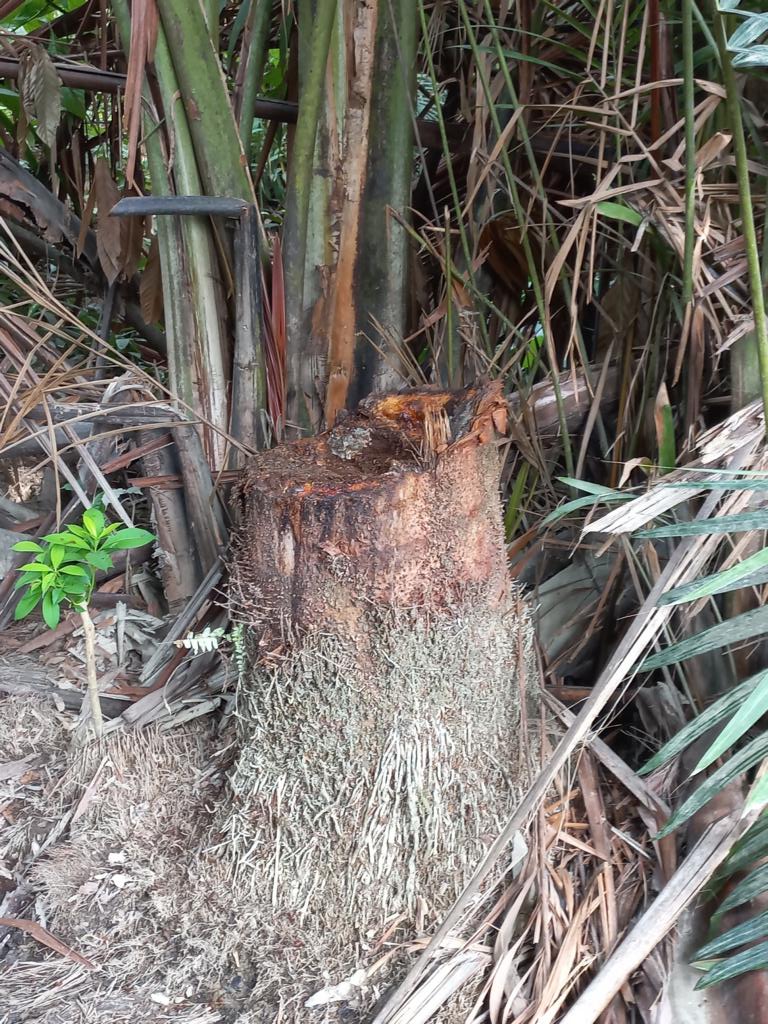
At Siberut Island, palm weevils will primarily infest sago palms. They also target sugar palms, coconut palms, and other palm species with starchy heartwood.
The life cycle of Palm Weevils
- Like all holometabolic insects, palm weevils have four developmental stages: eggs, larvae with various instars, pupae, and adults.
- Palm weevils are capable flyers and can travel 10-50 km/day. The distance from mainland West Sumatra to Pini Island is about 38 km. It is only a short distance from Pini to Tanah Bala Island; from Tanah Bala to Siberut Island, it is about 40 km as the crow flies. That means palm weevils could have flown via this route from the mainland to Siberut Island.
- Fresh wounds on palms release organic volatiles, which attract and stimulate palm weevil females to lay their eggs.
- Every female can lay up to 250 eggs in her lifetime.
- Eggs are hatching 3-6 days after laying.
- Larvae develop over 7-16 instars within 1-3 months.
- The weight of the final larval instar depends on the palm weevil species but is, on average, between 4–7 g/0.14-0.25 oz at a size of 5×2 cm/2×0.8’’.
- The final larval instars pupate in cocoons of palm fiber, from which, after 13-17 days, adult-winged weevils emerge.
- Adult weevils leave their palms and seek new food sources and mates. Winged beetles have a total lifetime of about four months.
How to eat them?
After cutting open palm trunks containing sago worms, these will be collected and brought home to the Uma. They will be washed in water to remove tree fibers. The cleaned, live larval instars were eaten as a side to sago sticks. Contrary to various YouTube videos and similar videos, none of the larvae were boiled or grilled, but all were eaten alive without spices.
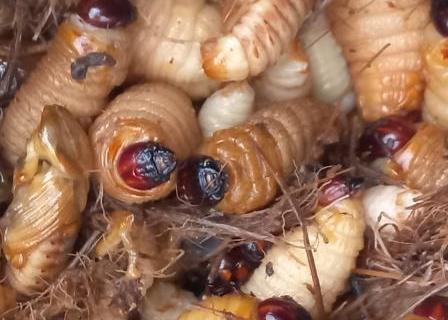
I can compare the taste and texture of these sago worms eaten at Siberut Island with Rhynchophorus ferrugineus (Red palm weevil) in Northern Vietnam and the Mekong Delta. After having eaten about 20 sago worms in various instar developments at Siberut, the following differences were observed:
- The sago worms on Siberut (R. lobatus or undescribed species) were smaller than R. ferrugineus.
- Their skin was tougher.
- The taste of these sago worms at Siberut Island was inferior to R. ferrugineus. They were not as sweet and milky as their Vietnamese counterparts.
- Pupae tasted the same at both species.
Nutritional value

Proximate, fatty acid, amino acid composition of fresh sago worms, © Intan R Nirmala et al.
The result shows that 100 g of fresh sago worms contain about 4% Carbohydrates, 10% protein, and over 20% fats. The composition of fatty acids can be seen in the table above. Based on these nutritional properties, the sago grub can be considered a good source of nutrients and counteract malnutrition based on a starchy diet.
Lessons learned about sago worms at Siberut Island:
- Sago worms at Siberut were either R. vulneratus or another species, which could not be identified.
- The larvae of this unidentified species of palm weevils were smaller and had tougher skin than R. ferruginous.
- These larvae were also less sweet and tasted less milky than the Red Palm Weevil.
More articles on this website about caterpillars can be found via the following links:
Edible caterpillars in D.R. Congo, Introduction
Edible caterpillars in D.R. Congo, Part 1
Edible caterpillars in D.R. Congo, Part 2
Edible caterpillars Nudaurelia sp.
Collection of edible caterpillars in D.R. Congo
Edible caterpillars for food in Congo
Stinging nettle slug caterpillar in Vietnam
Green caterpillars, called ‘Kaba’
.



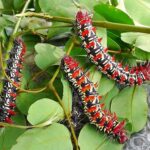
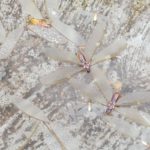
2 comments
Walid Kaakeh
Dear Prof.
I am in the process of preparing a new publication, related to red palm weevil, in Arabic language. I would like to get your permission to use images of the red palm weevil from your website page.
You will be acknowledged under each selected image and in the reference section. My plan is to publish the book by a non-profit organization such as a University or other NPOs.
Looking forward to hearing from you.
Regards
Walid Kaakeh
Emeritus Professor of Entomology
Sent from Mail for Windows
Kurt Hoelzl
Dear Prof. Kaakeh,
I agree that you use images from the referred article for your publication.
Independently from my agreement, it would be great if, after publication, you either would send me an online copy of your book or let me know where I could physically get it.
Kindest regards,
Kurt Hoelzl